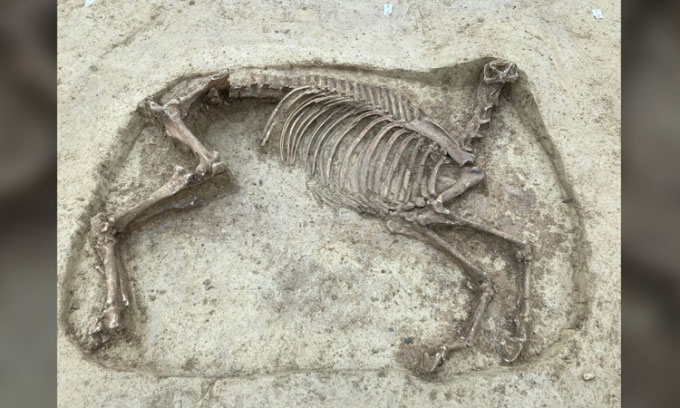Experts are unsure why the man was buried next to a headless horse, but it may be part of a burial ritual with grave goods.
Scientists have discovered the remains of a man buried 1,400 years ago near a headless horse at a ancient cemetery in Knittlingen, southern Germany, Live Science reported on February 2. This individual was likely the owner or rider of the horse.

The headless horse skeleton next to the remains of a 1,400-year-old man. (Photo: Stuttgart Regional Council’s Office for Monument Preservation/F. Damminger).
The man was buried during the Merovingian dynasty (476 – 750 AD), which thrived in the region, ruling over a vast territory that now encompasses France and Central Europe. During his life, he may have served the kings of the dynasty.
“The man is positioned in a ‘chain of command’ with Merovingian kings at the top, meaning he had obligations to participate in the king’s campaigns. As a member of the local elite, he was likely the head of a farming household consisting of family members and servants,” said Folke Damminger, the archaeologist in charge of the excavation at Knittlingen. However, according to Damminger, the man was not a farmer in the strictest sense, as much of the farming work may have been performed by other laborers.
The team of experts is unclear about the exact reason why the man was buried near a headless horse. However, it is highly likely that the beheading of the horse was part of a burial ritual, according to Damminger. The horse may have been placed near its owner as a grave good for the afterlife rather than as a sacrifice. Currently, scientists have not yet found the horse’s head.
Family members wanted to portray the man as a wealthy and important individual benefiting from his status. “One function of the ceremony is to ‘recreate’ the deceased with their former status and wealth as a statement from the heirs to maintain that status,” Damminger explained.
The archaeological team also discovered the remains of several other individuals from the same period as the horse rider in the ancient cemetery. Some were buried with valuable grave goods, such as a woman with a gold hairpin. Several men were buried with various weapons like swords, spears, shields, and arrowheads.
Researchers will continue to study the grave with the headless horse and excavate other graves in the cemetery. Damminger stated that they are currently excavating and restoring the grave goods of the mysterious man. Following this, they will conduct anthropological analyses of the man’s bones and teeth to learn about his health, age, and the cause of death.


















































